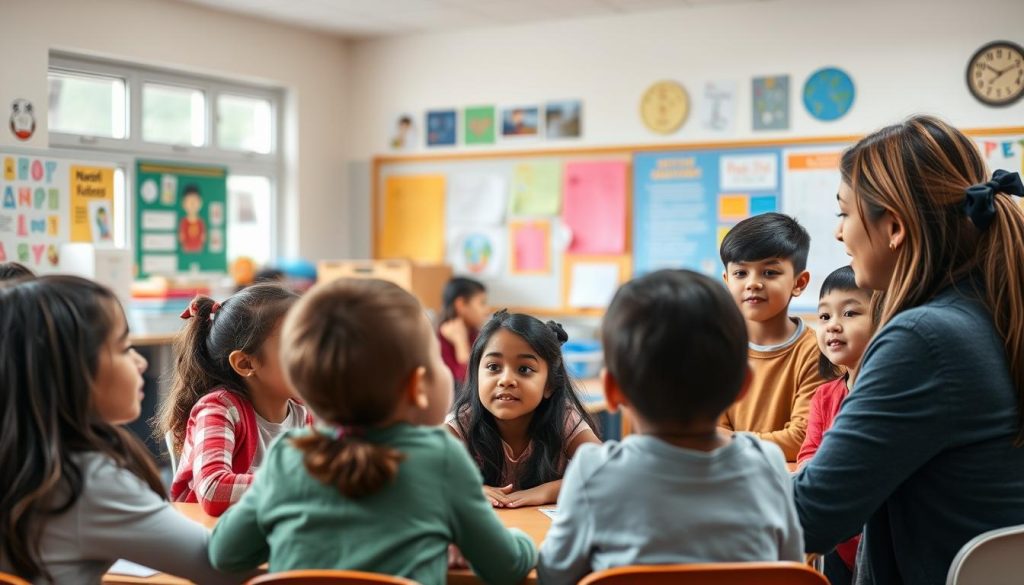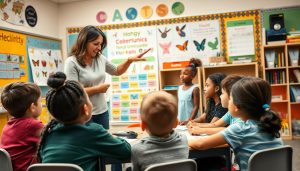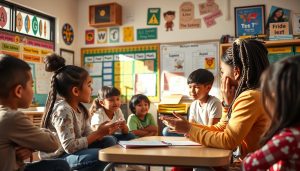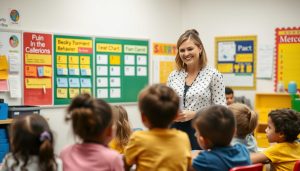Understanding the Difference: Fixed vs. Growth Mindset
Before diving into the steps to shift from a fixed to a growth mindset, it’s essential to understand what these terms mean in an educational context. The concept of fixed and growth mindsets was pioneered by Stanford psychologist Carol Dweck through decades of research on achievement and success.
A fixed mindset assumes that our character, intelligence, and creative ability are static givens that we cannot change in any meaningful way. In a classroom with a fixed mindset culture, students believe their abilities are innate talents. They might think, “I’m not a math person” or “I’ll never be good at writing.”
A growth mindset, on the other hand, thrives on challenge and sees failure as a heartening springboard for growth. In growth-oriented classrooms, students understand that their talents and abilities can be developed through effort, good teaching, and persistence.
Fixed vs. Growth Mindset in the Classroom
“In a growth mindset, challenges are exciting rather than threatening. So rather than thinking, ‘Oh, I’m going to reveal my weaknesses,’ you say, ‘Wow, here’s a chance to grow.'” — Carol Dweck
For teachers, embracing a growth mindset means developing teacher skills that focus on the process of learning rather than just the outcomes. It means celebrating effort, strategy, and progress rather than just natural talent or high grades.
Step 1: How to Shift from Fixed to a Growth Mindset Through Self-Assessment
The journey to transform your classroom begins with honest self-reflection. Before you can effectively foster a growth mindset in your students, you need to examine your own mindset as an educator.

Self-reflection is the first step in developing growth-oriented teacher skills
Assess Your Current Mindset
Start by asking yourself these questions:
- How do I respond when students struggle with concepts?
- Do I believe all students can improve with effort and good strategies?
- How do I talk about intelligence and ability in my classroom?
- Do I model persistence when facing challenges?
- How do I frame mistakes—as failures or learning opportunities?
Your answers will reveal whether you lean toward a fixed or growth mindset in your teaching practice. Many of us have a mixture of both mindsets, often varying by subject area or teaching situation.
Identify Your Fixed Mindset Triggers
Even teachers committed to growth mindset principles can have “fixed mindset triggers”—situations that activate fixed mindset thinking. Common triggers include:
- Facing a class that’s significantly behind grade level
- Working with students who seem unmotivated
- Implementing new teaching strategies or technologies
- Receiving critical feedback from administrators or parents
- Comparing your students’ performance to other classes
Recognizing these triggers is a crucial teacher skill that allows you to prepare growth-oriented responses rather than defaulting to fixed mindset reactions.
Ready to Deepen Your Growth Mindset Journey?
Explore our comprehensive course on implementing growth mindset strategies in your classroom. Designed specifically for K-12 teachers, this resource will transform your teacher skills and student outcomes.
Step 2: Reframe Your Language and Feedback Approach
The words we use as teachers have tremendous power to either reinforce a fixed mindset or cultivate a growth mindset. Developing teacher skills in mindful communication is essential for creating a growth-oriented classroom.
Fixed vs. Growth Mindset Language
| Fixed Mindset Phrases | Growth Mindset Alternatives |
| “You’re so smart!” | “I noticed how hard you worked on this.” |
| “Some students just aren’t good at math.” | “Everyone can improve their math skills with practice and good strategies.” |
| “This is easy, you should get it.” | “This might take some time and effort to understand, and that’s okay.” |
| “Great job! You got an A without even studying!” | “I’m interested to hear what strategies you used to prepare for this test.” |
| “Not everyone is cut out for advanced classes.” | “With the right support and effort, you can tackle challenging material.” |

The language we use shapes students’ beliefs about their abilities and potential for growth.
Pro Tip: Record yourself teaching a lesson, then review it specifically looking for fixed vs. growth mindset language. This reflective practice is a powerful teacher skill that can accelerate your mindset transformation.
Process-Focused Feedback
A key teacher skill for promoting a growth mindset is providing feedback that focuses on process rather than person. Research by Carol Dweck shows that praise focused on intelligence (“You’re so smart!”) can actually undermine motivation and performance, while process praise (“I like how you tried different strategies”) enhances motivation and improvement.
Effective process feedback:
- Highlights specific strategies used
- Acknowledges effort and persistence
- Connects actions to outcomes
- Offers next steps for improvement
- Normalizes struggle as part of learning
By consistently using growth-oriented language and feedback, you’re not just teaching content—you’re teaching students how to think about learning itself.
Step 3: Embrace Mistakes as Learning Opportunities
One of the most powerful ways to shift from a fixed to a growth mindset in teaching is to transform how mistakes are perceived and handled in your classroom. In traditional educational settings, mistakes are often seen as failures to be avoided or hidden. In a growth mindset classroom, they become valuable learning tools.
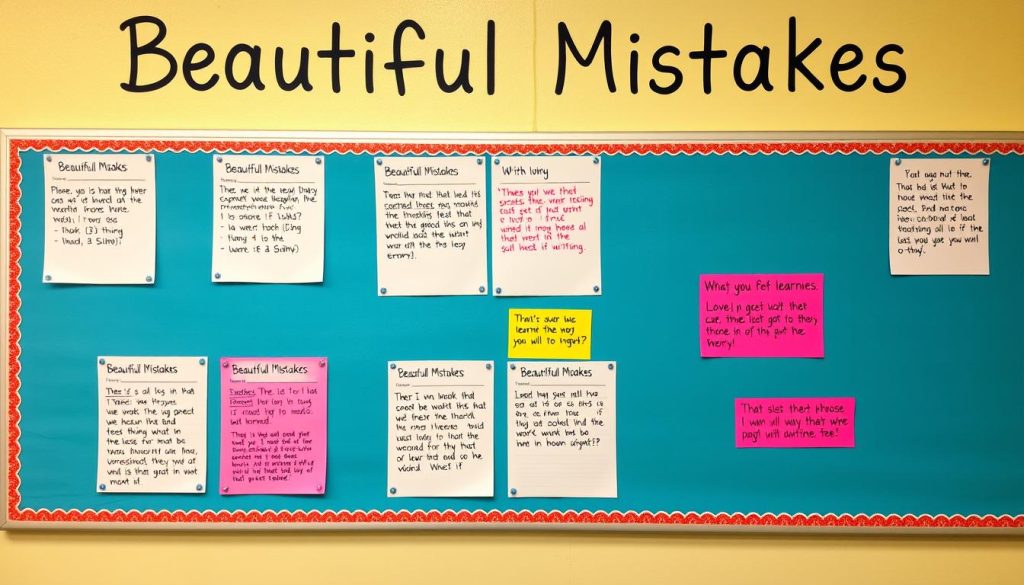
Creating a classroom culture that celebrates learning from mistakes
Modeling Mistake Management
As teachers, we have a powerful opportunity to model how to respond to mistakes. When you make an error in class (whether in content, instructions, or judgment), use it as a teachable moment:
- Acknowledge the mistake openly
- Demonstrate a positive, curious response rather than embarrassment
- Think aloud about what you learned
- Show how you’ll adjust moving forward
This modeling is a critical teacher skill that shows students that everyone, even experts, makes mistakes and can grow from them.
“The most successful people in life see mistakes as stepping stones rather than stumbling blocks. As teachers, we can help students develop this perspective through our own example.”
Classroom Strategies for Embracing Mistakes
Try these practical approaches to build mistake-positive teacher skills:
- My Favorite Mistake: Regularly highlight an anonymous student mistake that demonstrates a common misconception, then analyze it together
- Error Analysis: Have students review their tests/assignments to identify patterns in their mistakes and create improvement plans
- Mistake Journals: Encourage students to keep track of their mistakes and what they learned from them
- Growth Portfolios: Have students collect work samples showing progress over time, including early “mistake-filled” drafts
By implementing these strategies, you’ll develop teacher skills that transform the emotional climate around mistakes in your classroom.
Did you know? Credits for Teachers offers professional development opportunities that count toward continuing education requirements while helping you build growth mindset teaching strategies.
Step 4: How to Shift from Fixed to a Growth Mindset Through Challenging Tasks
A growth mindset classroom thrives on appropriate challenges. When we consistently provide students with work that stretches their abilities—but with adequate support—we create the perfect conditions for developing resilience and learning strategies.
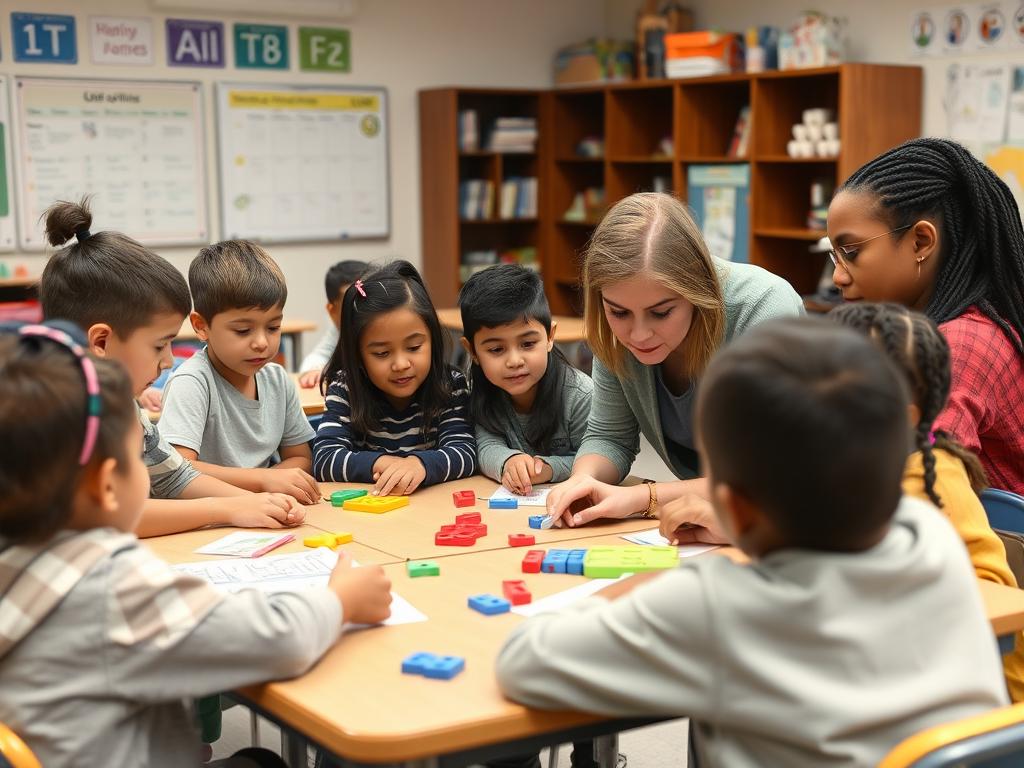
The Learning Zone Model
Effective challenge is about finding the sweet spot between comfort and frustration. Teacher skills in differentiation are essential here. Consider these three zones:
Comfort Zone
Tasks students can complete easily with existing skills. Provides confidence but little growth.
Learning Zone
Tasks that stretch students’ abilities but are achievable with effort and support. Optimal for growth.
Panic Zone
Tasks so far beyond current abilities that students feel overwhelmed. Leads to shutdown rather than growth.
The goal is to keep students primarily in the learning zone, where productive struggle leads to growth. This requires developing teacher skills in task design and differentiation.
Strategies for Creating Productive Challenge
- Low Floor, High Ceiling Tasks: Design activities accessible to all students but with room for extension
- Tiered Assignments: Create multiple versions of tasks at different challenge levels
- Choice Boards: Offer options that allow students to select appropriate challenge levels
- Scaffolded Support: Provide tools and supports that can be gradually removed as students develop competence
“In the beginner’s mind there are many possibilities, in the expert’s mind there are few.” — Shunryu Suzuki
This zen concept reminds us that approaching challenges with openness rather than fixed expectations creates space for growth.
Remember that developing teacher skills in creating appropriate challenges takes time. Start small by redesigning one lesson or unit to incorporate more productive struggle, then expand as you and your students become more comfortable with this approach.
Need Ready-to-Use Challenge Activities?
Our Growth Mindset in the Classroom course includes dozens of differentiated challenge activities designed to promote productive struggle across grade levels and subject areas.
Step 5: Teach the Neuroscience of Learning
A powerful strategy to shift from a fixed to a growth mindset in teaching is helping students understand how their brains actually change and grow when they learn. When students grasp that intelligence isn’t fixed but malleable, their motivation and persistence often dramatically improve.
Brain Basics for Students
You don’t need advanced neuroscience knowledge to teach students these key concepts:
- Neuroplasticity: The brain’s ability to form new connections throughout life
- Strengthening Neural Pathways: How practice makes certain brain connections stronger
- The Role of Mistakes: How errors help the brain identify and strengthen weak connections
- The Learning Process: How struggle and effort physically change the brain
Developing teacher skills in explaining these concepts in age-appropriate ways can transform how students approach learning challenges.
Classroom Activities to Teach Brain Growth
Try these grade-appropriate activities to develop your teacher skills in neuroscience education:
Elementary Grades
- Use pipe cleaners to model neural connections
- Read books like “Your Fantastic Elastic Brain”
- Compare brain to a muscle that gets stronger with exercise
Middle Grades
- Create brain models showing before/after learning
- Analyze learning progress data to see growth
- Journal about “brain growing” moments
High School
- Research neuroscience studies on learning
- Track skill development in specific areas
- Analyze factors that enhance/inhibit brain growth
Research shows that students who understand how their brains grow with effort are more likely to persevere through challenges and setbacks. By teaching this science, you’re providing students with a powerful internal motivation system.
Teacher Reflection: How might your own understanding of brain plasticity influence your expectations for students who are currently struggling? How could you use this knowledge to shift from a fixed to a growth mindset in your teaching approach?
Step 6: How to Shift from Fixed to a Growth Mindset Through Goal Setting
Effective goal setting is a cornerstone of growth mindset teaching. The way we structure, monitor, and celebrate goals can either reinforce fixed thinking or cultivate a growth orientation in our students and ourselves.

Collaborative goal-setting helps students develop ownership of their learning journey
Process vs. Outcome Goals
A key teacher skill for promoting growth mindset is understanding the difference between process and outcome goals:
Outcome Goals (Fixed Mindset)
- Focus on end results
- Example: “Get an A on the test”
- Success depends only on achievement
- Can lead to shortcuts or cheating
- Failure feels personal and permanent
Process Goals (Growth Mindset)
- Focus on actions and strategies
- Example: “Study 20 minutes daily using flashcards”
- Success comes from following the process
- Builds sustainable learning habits
- Failure becomes feedback about the process
While outcome goals have their place, process goals are more aligned with a growth mindset because they emphasize factors within students’ control and focus attention on improvement strategies.
SMART-E Goal Framework for Growth Mindset
Enhance your teacher skills by using this modified SMART framework that incorporates growth mindset principles:
- Specific: Clear, concrete actions rather than vague intentions
- Measurable: Progress can be tracked objectively
- Achievable: Challenging but possible with effort and support
- Relevant: Connected to meaningful learning and personal interests
- Time-bound: Has specific checkpoints and deadlines
- Effort-focused: Emphasizes process and strategy over natural ability
“Goals are not meant to be easy to reach; they’re meant to be worth reaching.”
By teaching students to set and monitor process-focused goals, you help them develop metacognitive skills and internal motivation that will serve them well beyond your classroom.
Looking for more resources on growth mindset goal setting? Credits for Teachers offers professional development courses that include ready-to-use goal setting templates and tracking tools for K-12 classrooms.
Step 7: Build a Growth Mindset Classroom Community
The final step to shift from a fixed to a growth mindset in teaching involves creating a classroom culture where growth mindset principles are woven into every aspect of daily life. This community approach reinforces and sustains the mindset shift for both you and your students.
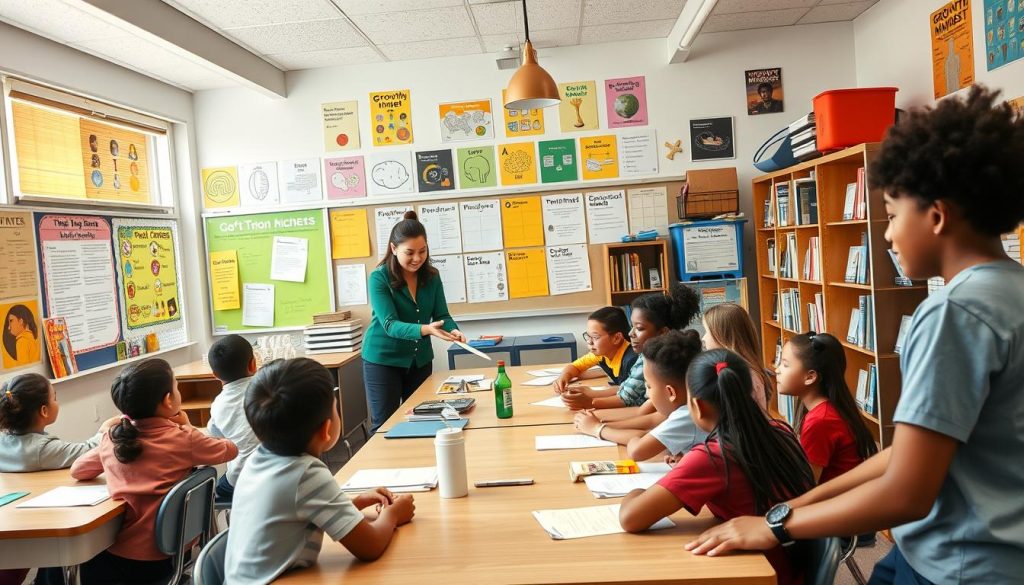
Environmental Elements
Your physical classroom environment can powerfully reinforce growth mindset principles. Consider including:
- Process Displays: Show the progression of work from first draft to final product
- Growth Language: Post phrases like “I can’t do it…yet” and “Mistakes help me learn”
- Learning Pit Visuals: Illustrate the normal struggle phase of learning
- Celebration of Effort: Recognize persistence and strategy use, not just achievement
- Role Models: Share stories of famous figures who overcame setbacks
Collaborative Learning Structures
Develop teacher skills in facilitating these growth-oriented collaborative practices:
- Peer Feedback: Teach students to give process-focused feedback to each other
- Group Problem-Solving: Create challenges that require combining different strengths
- Skill Sharing: Allow students to teach each other strategies they’ve mastered
- Reflection Circles: Regular discussions about learning processes and growth
“Alone we can do so little; together we can do so much.” — Helen Keller
This quote reminds us that growth mindset flourishes in community.
Involving Families
Extend your growth mindset community beyond classroom walls by developing these teacher skills:
- Share growth mindset principles in family newsletters
- Provide conversation starters that reinforce process praise at home
- Create homework that involves family members in growth-oriented reflection
- Host family workshops on supporting growth mindset at home
By creating a consistent growth mindset environment across school and home, you maximize the impact of your mindset shift and create lasting change in how students approach learning.
Embracing the Journey: Your Growth Mindset Transformation
The shift from a fixed to a growth mindset in teaching is not a destination but a continuous journey. As you implement these seven steps, remember that developing new teacher skills takes time and that setbacks are part of the growth process.
Start small by choosing one or two strategies from this guide that resonate most strongly with your current teaching context. As you gain confidence and see positive results, gradually incorporate more elements into your practice.
The most powerful aspect of this transformation is that it benefits both you and your students. As you model growth mindset principles, you’ll likely find yourself more resilient in the face of teaching challenges, more creative in your approach to instruction, and more fulfilled in your professional role.
“The greatest teacher is not the one who knows most but the one who is most capable of reducing knowledge to that simple compound of the obvious and wonderful.” — John Louis Sullivan
By embracing a growth mindset in your teaching, you create a classroom where learning is not just about acquiring knowledge but about developing the resilience, curiosity, and strategic thinking that will serve students throughout their lives.
Ready to Deepen Your Growth Mindset Journey?
Take the next step in your professional development with our comprehensive Growth Mindset in the Classroom course. Designed specifically for K-12 teachers, this resource provides practical strategies, ready-to-use materials, and ongoing support to transform your teaching practice.
Enroll in Growth Mindset Course
Visit Credits for Teachers to explore our full range of professional development opportunities.

